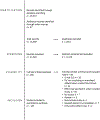Psychological Stress During Childhood and Adolescence and Its Association With Inflammation Across the Lifespan: A Critical Review and Meta-Analysis
- PMID: 39247904
- PMCID: PMC11378952
- DOI: 10.1037/bul0000351
Psychological Stress During Childhood and Adolescence and Its Association With Inflammation Across the Lifespan: A Critical Review and Meta-Analysis
Abstract
Psychological stress during childhood and adolescence increases risk of health problems across the lifecourse, and inflammation is implicated as an underlying mechanism. To evaluate the viability of this hypothesis, we used meta-analysis to quantify the association between childhood/adolescent stress and inflammation over the lifecourse. Furthermore, we addressed three unresolved conceptual questions: (a) Does the strength of this association change over the lifecourse? (b) Are different types of childhood/adolescent stressors differentially associated with inflammation? (c) And which components of the inflammatory response are involved? A systematic search identified 187 articles reporting 922 associations. Meta-analyses were conducted using a three-level multilevel approach and controlled for study quality, conversion confidence, and whether effect sizes were unadjusted or adjusted (n = 662, 72%). Results indicated a small but reliable overall adjusted association . The magnitude of the association strengthened across the lifecourse-effect sizes were smallest in studies that measured inflammation in childhood and became progressively larger in studies of adolescence and adulthood , suggesting the impact of early stress strengthens with time. By contrast, effect sizes did not vary by adversity type (socioeconomic disadvantage, maltreatment, other interpersonal stressors, and cumulative exposure across stressors), or component of inflammation (circulating biomarkers of low-grade inflammation vs. cytokine responses to microbial stimuli). Implications and future directions are discussed.
Keywords: childhood socioeconomic status; development; early adversity; health; maltreatment.
Conflict of interest statement
The authors declare no conflicts of interest.
Figures






Similar articles
-
Childhood socioeconomic status and inflammation: A systematic review and meta-analysis.Brain Behav Immun. 2019 May;78:161-176. doi: 10.1016/j.bbi.2019.01.018. Epub 2019 Feb 7. Brain Behav Immun. 2019. PMID: 30738842
-
Folic acid supplementation and malaria susceptibility and severity among people taking antifolate antimalarial drugs in endemic areas.Cochrane Database Syst Rev. 2022 Feb 1;2(2022):CD014217. doi: 10.1002/14651858.CD014217. Cochrane Database Syst Rev. 2022. PMID: 36321557 Free PMC article.
-
Association of lifecourse socioeconomic status with chronic inflammation and type 2 diabetes risk: the Whitehall II prospective cohort study.PLoS Med. 2013;10(7):e1001479. doi: 10.1371/journal.pmed.1001479. Epub 2013 Jul 2. PLoS Med. 2013. PMID: 23843750 Free PMC article.
-
Shorter Versus Longer Durations of Any Human Milk Feeding and Food Allergies, Allergic Rhinitis, Atopic Dermatitis, and Asthma: A Systematic Review [Internet].Alexandria (VA): USDA Nutrition Evidence Systematic Review; 2019 Apr. Alexandria (VA): USDA Nutrition Evidence Systematic Review; 2019 Apr. PMID: 35593772 Free Books & Documents. Review.
-
Effects of maltreatment on coping and emotion regulation in childhood and adolescence: A meta-analytic review.Child Abuse Negl. 2020 May;103:104446. doi: 10.1016/j.chiabu.2020.104446. Epub 2020 Mar 19. Child Abuse Negl. 2020. PMID: 32200195 Review.
Cited by
-
Associations Between Adolescent Pain and Psychopathology in the Adolescent Brain Cognitive Development (ABCD) Study.Behav Genet. 2023 May;53(3):232-248. doi: 10.1007/s10519-023-10138-x. Epub 2023 Apr 10. Behav Genet. 2023. PMID: 37036551 Free PMC article.
-
Stressful life events across the lifespan and inflammation: An integrative data analysis.Brain Behav Immun Health. 2024 Sep 16;41:100861. doi: 10.1016/j.bbih.2024.100861. eCollection 2024 Nov. Brain Behav Immun Health. 2024. PMID: 39381368 Free PMC article.
-
Childhood Maltreatment and Immune Cell Gene Regulation during Adolescence: Transcriptomics Highlight Non-Classical Monocytes.Biomolecules. 2024 Feb 13;14(2):220. doi: 10.3390/biom14020220. Biomolecules. 2024. PMID: 38397457 Free PMC article.
-
Intergenerational transmission of stress: Multi-domain stressors from maternal childhood and pregnancy predict children's mental health in a racially and socioeconomically diverse, multi-site cohort.Soc Psychiatry Psychiatr Epidemiol. 2023 Nov;58(11):1625-1636. doi: 10.1007/s00127-022-02401-z. Epub 2023 Feb 3. Soc Psychiatry Psychiatr Epidemiol. 2023. PMID: 36735003 Free PMC article.
-
Socioeconomic Disadvantage Moderates the Association of Systemic Inflammation With Amygdala Volume in Adolescents Over a 2-Year Interval: An Exploratory Study.Biol Psychiatry Cogn Neurosci Neuroimaging. 2024 Sep;9(9):896-904. doi: 10.1016/j.bpsc.2024.05.002. Epub 2024 May 28. Biol Psychiatry Cogn Neurosci Neuroimaging. 2024. PMID: 38815859
References
-
- Aas M, Dieset I, Hope S, Hoseth E, Mørch R, Reponen E, Steen NE, Laskemoen JF, Ueland T, Aukrust P, Agartz I, Andreassen OA, & Melle I (2017). Childhood maltreatment severity is associated with elevated C-reactive protein and body mass index in adults with schizophrenia and bipolar diagnoses. Brain, Behavior, and Immunity, 65, 342–349. 10.1016/j.bbi.2017.06.005 - DOI - PubMed
-
- Almuwaqqat Z, Wittbrodt M, Young A, Lima BB, Hammadah M, Garcia M, Elon L, Pearce B, Hu Y, & Sullivan S (2020). Association of early-life trauma and risk of adverse cardiovascular outcomes in young and middle-aged individuals with a history of myocardial infarction. JAMA Cardiology, 6(3), 336–340. 10.1001/jamacardio.2020.5749 - DOI - PMC - PubMed
Grants and funding
LinkOut - more resources
Full Text Sources

